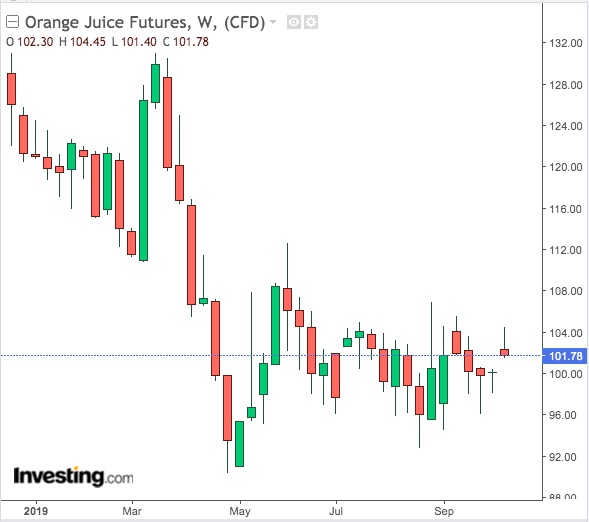The weather across America is blowing dry to cold, stressing crops and harvests and creating sudden bull opportunities for investors. In the Northern Plains, a crop freeze is developing in corn. In Florida, which sits right on the Atlantic Ocean, it’s arid air now for oranges.
On Tuesday, orange juice futures hit a near one-month high in New York on bets that dry conditions in top growing state Florida will result in a less favorable crop report from the U.S. Department of Agriculture.
The price pop in select agriculture and soft commodities such as corn and OJ comes as sector heavyweights like oil and gold labor in sluggish directionless trading.
Why We Need To Pay More Attention To OJ
Nick Scoville, principal ags and softs analyst at Chicago’s Price Futures Group, makes a case on why investors might want to pay more attention to OJ, America’s favorite citrus and breakfast staple.
“There are no threats out in the ocean right now but the state of Florida has been dry.”
“Many are expecting increased production estimates from Florida on Thursday when USDA releases its next production report, but the drier weather could mean reduced fruit sizes and less than expected production.”
OJ futures’ front-month contract, November, hit $1.0445 on Tuesday, its highest since Sept. 12.
'Strong Buy' Recommendation
Investing.com’s Daily Technical Outlook has a “Strong Buy” call on November OJ, pegging top-end resistance at $1.0866.
The last time OJ traded at such highs was in mid-April, when smaller-than-expected fruiting in Florida crops and worries of dry weather turned even pessimistic investors into buyers.
Andrew Hecht, an independent commodities analyst, noted in a recent post on OJ:
“The price of OJ futures tends to be highly sensitive to weather conditions in Florida over the winter season as freezes can cause significant rallies in the futures market.”
Still The No. 2 Worst Commodity Of 2019

But while OJ has rallied in five of the past seven weeks, it’s down almost 19% on the year, making it the worst performing commodity for 2019 after natural gas.
Scoville said short-term trends in OJ were higher, but chart patterns were mixed. He also stressed that there was no alarm yet over supply, with Florida orange inventories still standing at nearly 30% above year-ago levels. In terms of crop progress, he said fruits were developing in dry weather.
In Brazil, the biggest citrus competitor to Florida, Scoville said there were rains instead, amid flowering for the next crop.
Brazil's Real Could Ultimately Decide Longer-Term Price Moves
Hecht said there was potential for OJ to cut its 2019 losses significantly with an extended rally in the real, the currency which determines domestic citrus prices in Brazil and also influences U.S. pricing via Brazilian imports.
The real hit a three-week high of $4.0607 to the dollar recently.
Said Hecht:
“The potential for supply issues is always a danger when it comes to these agricultural commodities markets, and supply issues can cause explosive price moves.”
“The Brazilian real versus US dollar relationship is likely to impact ... FCOJ prices in Q4 as Brazil is the world's leading producer and exporter. Domestic production costs are in local currency terms, so a rise in the Brazilian real would likely put upward pressure on dollar-based prices.”
